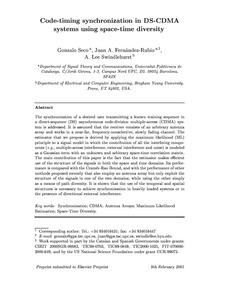Mostra el registre d'ítem simple
Code-timing synchronization in DS-CDMA systems using space-time diversity
| dc.contributor.author | Seco Granados, Gonzalo |
| dc.contributor.author | Fernández Rubio, Juan Antonio |
| dc.contributor.other | Universitat Politècnica de Catalunya. Departament de Teoria del Senyal i Comunicacions |
| dc.date.accessioned | 2017-04-25T15:13:42Z |
| dc.date.available | 2017-04-25T15:13:42Z |
| dc.date.issued | 1999 |
| dc.identifier.citation | Seco, G., Fernandez, J. Code-timing synchronization in DS-CDMA systems using space-time diversity. A: Baiona Workshop on Emerging Technologies in Telecommunications. "Fifth Baiona Workshop on Emerging Technologies in Telecommunications: based on the proceedings of a conference organized by the University of Vigo, held at Baiona in September 1999". Baiona: Servicio de Publicaciones Universidad de Vigo, 1999, p. 173-177. |
| dc.identifier.isbn | 8-4815-8129-1 |
| dc.identifier.uri | http://hdl.handle.net/2117/103724 |
| dc.description.abstract | The synchronization of a desired user transmitting a known training sequence in a direct-sequence (DS) asynchronous code-division multiple-access (CDMA) sys-tem is addressed. It is assumed that the receiver consists of an arbitrary antenna array and works in a near-far, frequency-nonselective, slowly fading channel. The estimator that we propose is derived by applying the maximum likelihood (ML) principle to a signal model in which the contribution of all the interfering compo-nents (e.g., multiple-access interference, external interference and noise) is modeled as a Gaussian term with an unknown and arbitrary space-time correlation matrix. The main contribution of this paper is the fact that the estimator makes eÆcient use of the structure of the signals in both the space and time domains. Its perfor-mance is compared with the Cramer-Rao Bound, and with the performance of other methods proposed recently that also employ an antenna array but only exploit the structure of the signals in one of the two domains, while using the other simply as a means of path diversity. It is shown that the use of the temporal and spatial structures is necessary to achieve synchronization in heavily loaded systems or in the presence of directional external interference. |
| dc.format.extent | 5 p. |
| dc.language.iso | eng |
| dc.publisher | Servicio de Publicaciones Universidad de Vigo |
| dc.rights | Attribution-NonCommercial-NoDerivs 3.0 Spain |
| dc.rights.uri | http://creativecommons.org/licenses/by-nc-nd/3.0/es/ |
| dc.subject | Àrees temàtiques de la UPC::Enginyeria de la telecomunicació |
| dc.subject.lcsh | Telecommunication |
| dc.subject.other | Synchronization |
| dc.subject.other | CDMA |
| dc.subject.other | Antenna Arrays |
| dc.subject.other | Maximum Likelihood Estimation |
| dc.subject.other | Space-Time Diversity |
| dc.title | Code-timing synchronization in DS-CDMA systems using space-time diversity |
| dc.type | Conference report |
| dc.subject.lemac | Telecomunicació |
| dc.contributor.group | Universitat Politècnica de Catalunya. SPCOM - Grup de Recerca de Processament del Senyal i Comunicacions |
| dc.identifier.doi | 10.1016/S0165-1684(01)00074-3 |
| dc.description.peerreviewed | Peer Reviewed |
| dc.relation.publisherversion | http://www.sciencedirect.com/science/article/pii/S0165168401000743 |
| dc.rights.access | Open Access |
| local.identifier.drac | 2434111 |
| dc.description.version | Postprint (published version) |
| local.citation.author | Seco, G.; Fernandez, J. |
| local.citation.contributor | Baiona Workshop on Emerging Technologies in Telecommunications |
| local.citation.pubplace | Baiona |
| local.citation.publicationName | Fifth Baiona Workshop on Emerging Technologies in Telecommunications: based on the proceedings of a conference organized by the University of Vigo, held at Baiona in September 1999 |
| local.citation.startingPage | 173 |
| local.citation.endingPage | 177 |


